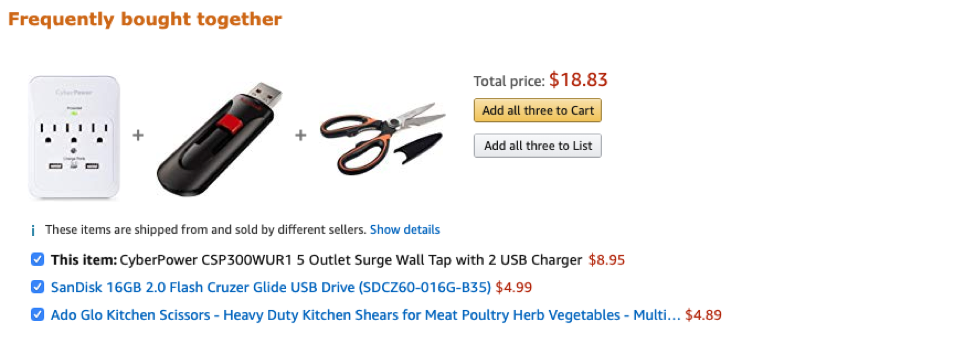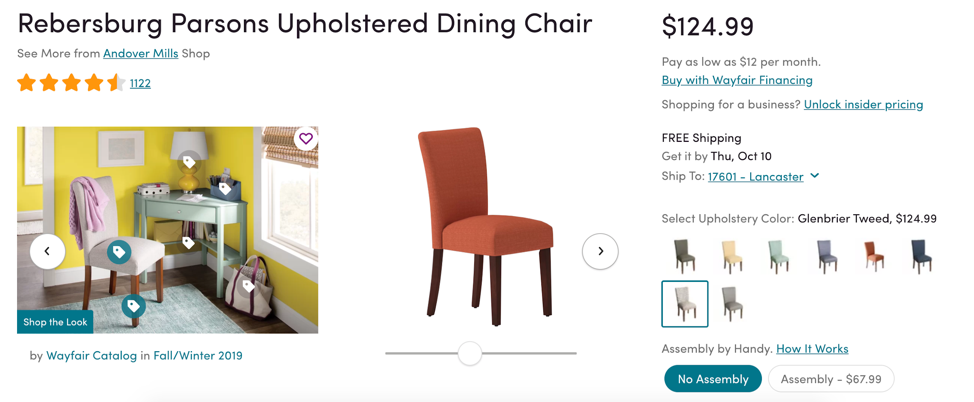It’s simple to think of old-fashioned, brick and mortar commerce as vastly different from the seemingly quick, bustling world of ecommerce. You might even believe the strategies developed for offline selling don’t work online. Yet the truth is, the tried and tested strategies of traditional commerce work just as well (and maybe even better) for ecommerce.
Two great examples of traditional commerce strategies working wonders online are upselling and cross-selling.
In fact, Amazon has stated up to 35% of its revenue comes from cross-selling. Additionally, another study found upselling is responsible for 4% of all ecommerce sales.
We’ll take a look at both cross-selling and upselling strategies and the various ways you can implement them across your ecommerce site. Let’s begin with some quick definitions of both.
What are upselling and cross selling?
If you are from a traditional commerce setting, you’ve likely heard the terms upsell and cross-sell before. There’s a good chance you’ve come across them if you’re in the ecommerce space, too.
However, it’s easy to confuse the two. People often believe they’re the same thing, but they’re two entirely separate strategies.
Upselling
The upsell: a tale as old as time. In a nutshell, upselling is getting a buyer to purchase a better version of what they came in for. An upsell involves the same product – either as an upgraded or luxury version. We’ve all likely experienced an upsell before.
In the ecomm world, we see upselling all of the time. If you’ve ever spent time on Amazon comparing the specs between different models of the same product, then you’ve experienced a common upselling strategy.
Cross-selling
Cross-selling is all about getting your customer to buy an additional, closely related product. If you’ve ever been asked, “Do you want fries with that?” Then you’ve encountered cross-selling.
Cross-selling might also look like recommended software or peripheral equipment for a laptop or computer at the checkout page. In its simplest form, cross-selling adds value to a purchase, for both the buyer and the seller.
Successful ecommerce strategies
The question now is, how can you implement upselling and cross-selling into your ecommerce strategy? A number of ways exist, and we’ve detailed several of them below.
Bundling
Offering several items together in a bundle is a great way to cross-sell products. This can be especially attractive to a customer if the bundle price is lower than the sum of buying the products individually. Many sites also do this as a way to simply and effectively group complementary items together. Below is an often-used bundling technique from Amazon.

Bundling can not only increase average sale totals, but it also helps save both you and your customers money if you charge a flat-rate for shipping.
Recommended items
Similar to a bundle, recommended item lists are a great strategy for increasing sales. Amazon, again, makes use of recommended items on almost every product page.

In this case, Amazon is showing a customer other related items to consider. Whether it’s other styles of clothing or additional items for a desktop computer, this is an equally effective ecomm technique that you can implement on your site.
Side-by-side comparisons
Another powerful tool is upselling through side-by-side comparisons of the different models of a product you sell. This is often used for consumer electronics where a single item might have multiple models with differing specifications.

Placing your higher-priced, more sophisticated products alongside your baseline models showcases their advanced features and lets consumers know exactly where they are compromising. And if your shopper isn’t looking to compromise, you’ve earned a higher sale.
Offering premium add-ons and services
Large retailers like Walmart and Best Buy annually earn large profits by selling extended protection plans on everything from electronics to children’s toys.
This type of add-on is often seen at the checkout screen. Want in-home installation? What about a three year warranty on your new camera? Each of these incentives are an added value to customers and can help boost your cross-selling numbers.
Add-ons are also great for upselling. Beauty retailers can included free test samples of higher end items to entice shoppers and introduce them to a luxury they didn’t know they needed. The next time they shop, consumers just might ditch their budget brand and splurge on the indulgence.
“Shop the look”
This is a cross-selling strategy commonly used for lifestyle and fashion products. Sellers who include high-quality images or videos of products in real-life scenes can spur additional purchases of related items.
Wayfair is a great example of employing the “shop the look” strategy across many of their products. Here you can see how Wayfair includes the current item in a showroom style image with five other items they sell, with pricing and links included for each item in the image.

Wayfair is known for their in-depth tools and features ranging from augmented reality applications to full 360 degree views of items.
While most ecommerce retailers won’t need that level of technology, Wayfair still makes use of seemingly simple, catalog-inspired “shop the look” to capture high-value shoppers looking to mimic their stylized décor.
Implementing cross-selling and upselling strategies on your site
Implementing these strategies can be challenging and varies depending on the platform that you’re using. Some ecommerce sites, like Amazon, provide sellers with limited control over site functionality. Other ecomm platforms, like Shopify, offer deeper levels of user customization through plug-ins.
Amazon
If you’re a seller on Amazon, you don’t have complete control over how or where Amazon displays your products. You can’t simply tell Amazon which items to bundle or recommend with similar products. However, the best way to ensure that your products are getting the most cross-selling screen real estate begins with Amazon SEO.
Making sure that your product pages are properly optimized not only directly benefit your sales (which Amazon loves) but it will also provide the Amazon algorithm with more information about your product. This in turn helps Amazon determine what other products to recommend yours alongside. Shoppers will also start seeing your products listed alongside relevant items from other sellers.
All of these add up, and sellers can see marked improvements in exposure, brand awareness, and sales on Amazon.
Ecommerce platforms
If you’re using a third-party ecommerce platform like WooCommerce, Magento, or Shopify, then you’re in luck. Many of these platforms offer plug-ins or add-ons that allow for implementing many of the same upselling and cross-selling strategies we’ve seen on sites like Amazon or Wayfair.
Shopify is a particularly robust platform and offers a ton of plug-ins right in their app store. The sophistication of such upselling plug-ins differs across ecomm platforms. This should be an important feature to consider when starting your first ecommerce site or thinking of migrating to a new platform.
Contact a web developer
Some platforms are not going to offer the same level of easily integrated support, and in these cases, it’s best to contact a developer to help you build these features into your ecommerce site. A developer will provide guidance and support in deciding the best approach for implementing the upsell and cross-sell strategies for your site.
Whether you’re new to ecommerce or a seasoned veteran, strategies like cross-selling and upselling can be hugely beneficial to your company.
